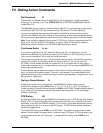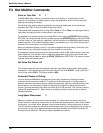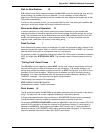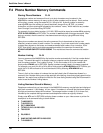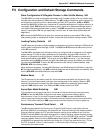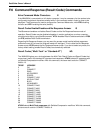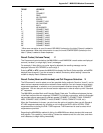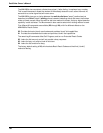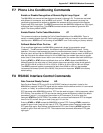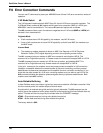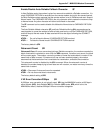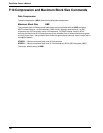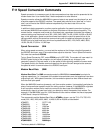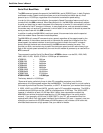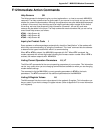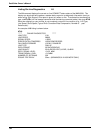
137
Appendix F - MMH2834 Modem Commands
F.7 Phone Line Conditioning Commands
Enable or Disable Recognition of Remote Digital Loop Signal &T
The MMH2834 has several self-test features (covered in Appendix G). The tests are activated
with different U commands, such as ATU1, and so fortF. The &T command is a phone line
conditioning command that enables or disables the modem's ability to recognize the Remote
Digital Loop (RDL) test signal. The AT&T4 command lets the MMH2834 respond to a RDL signal,
and places itself in digital loop. The AT&T5 command causes the modem to ignore the RDL
signal. The factory default is &T5.
Enable/Disable Trellis Coded Modulation #T
This command enables or disables the Trellis Coded Modulation of the MMH2834. There is
usually no need to disable (turn-off) Trellis codings except under an unusual line condition called
impulse noise. AT#T0 turns Trellis coding off and AT#T1 turns Trellis coding on (factory default).
Fallback Modes When On-Line #F
If line conditions deteriorate, the MMH2834 automatically drops its transmission speed
(“fallback”). The #F command control the different ways the MMN2834 falls back. During
operation, if the error rate becomes too great, the modem performs a retrain. If after the retrain,
the error rate is still too high for 28800 bps operation, the modem initiates a retrain at 4800 bps.If
after the first retrain the modem returns on line at 28800 bps, the modem then starts a counter
and a timer. If three retrains occur within a two minute period, the modem falls back to 4800 bps.
Entering AT#F0 (or AT#F) allows no fallback when on-line. AT#F1 allows the MMH2834 to
fallback (based on the error rate or if three retrains have occurred within a two minute period)
from 28.8K to 26.4K to 24K to 21.6K to 19.2K to 16.8K to 14.4K to 12K to 9.6K to 4.8K bps.
The AT#F2 command enables incremental fall back from 28.8K to 4.8K, but also enables
incremental fall forward (from 4.8K to 28.8K) if the phone line improves. AT#F2 is the factory
default setting.
F.8 RS232C Interface Control Commands
Data Terminal Ready Control &D
Data Terminal Ready (DTR) on pin 20 of the RS232C interface is required in order for the
MMH2834 to operate. A high DTR signal tells the modem that the device to which it is connected
is active, or "ready" to communicate through the modem.
DTR has some other MMH2834 functions. DTR can be used to trigger a dialing sequence, called
DTR Dialing. The condition of DTR can also be used to cause the modem to reset to its default
parameters, just as if you had given the modem an ATZ command. To do this, enter the
command AT&D3 and hit RETURN. The modem will now reset itself whenever DTR is dropped
from On to Off, and will also go on-hook (hang up) if it is on-line.
Entering AT&D0 or AT&D causes the MMH2834 to ignore DTR. Entering AT&D1 causes the
modem to go on-hook (hang up) with loss of DTR. The modem enters Command mode when
DTR goes high again. Auto-answer is disabled while DTR is low. Entering AT&D2 causes the
modem to go on hook with loss of DTR. The modem enters command mode when DTR goes
high again.



